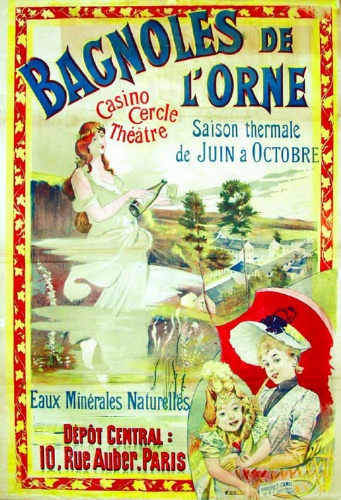This WebQuest requires students to investigate the idea of paradigm shifts through imagery found in advertising from the 20th and 21st century.
Introduction


Breaking Ground Advertising Wants You!
Breaking Ground Advertising is a progressive company looking for bright, young concept artists to decode advertisements from the past in order to create ads of the future. We want to stay ahead of the curve and understand that, sometimes, you have to regress before you can progress.
Take a moment and think of all the different imagery you see in advertisements in just one, normal day. Do you think advertisements have always looked the same throughout the last two decades? Have their messages changed? Have our belief systems changed? How and why? Just think of all the changes that happened with the advent of television in the 1950s. How will paradigms and advertisements change in the next 50 years? What will television commercials look like in the year 2058? Breaking Ground Advertising believes you can answer these important questions!
Task
In this WebQuest, you will be guided through information and imagery that will give you a better understanding of what paradigms are and how they can shift. It is designed to strengthen your critical thinking skills and awareness of the messages and belief systems that lie beneath the images in advertisements. Remember, there are no right or wrong answers, just creative predictions based on your online research.
It is your objective to research, analyze your findings and then use the new information to design/create a print advertisement or a TV commercial for the year 2050. Your advertisement/TV commercial for the year 2050 will be based on an advertisement/TV commercial from the past. By the "past", we mean from the 1950s to the present.
In order to be seriously considered for this position with Breaking Ground Advertising, you will be responsible for submitting your research notes, your final advertisement and a brief presentation based on your research.
Good luck!
Process
"The masses can only think in images and can only be influenced by means of pictures. Only pictures can frighten or persuade them and become the causes of their actions... To them, the unreal is almost as important as the real?
-Gustave LeBon Psychology of the Masses
 Before you can start generating ideas for your advertisements, you'll need to conduct some necessary research. In order to create successful advertisements with strong undercurrents, you'll need to fully understand what a paradigm is and how paradigm shifts occur. You will also learn how historical research connects the present with the past and aids in the development of fresh, new ideas. Your advertisement will also reveal your own individual perspectives and ethical/moral concerns, which will then inform the paradigms that manifest in your chosen imagery, text and overall layout.
Before you can start generating ideas for your advertisements, you'll need to conduct some necessary research. In order to create successful advertisements with strong undercurrents, you'll need to fully understand what a paradigm is and how paradigm shifts occur. You will also learn how historical research connects the present with the past and aids in the development of fresh, new ideas. Your advertisement will also reveal your own individual perspectives and ethical/moral concerns, which will then inform the paradigms that manifest in your chosen imagery, text and overall layout.
1. Take a look at the following advertisements:
1a. While viewing these advertisements, follow these simple guidelines to begin deconstructing the images. Answer all of these questions on a separate piece of paper for each image.
Review the VISUALS
Look at the images. Take notes on what you see.
What are the people in the advertisement doing?
What are the expressions on their faces?
What clothes are they wearing?
Who or what might be left out of the picture? Why?
Review the TEXT
Read every word in the ad- even the smallest font
What do the words say? what adjectives or adverbs are used?
How do they say it?
What might be left out? Why?
Review the LAYOUT
How do the words relate to the images?
Notice how your eye moves as it first encounters the ad?
Do you think your eyes are attracted to the brightest portion of the page?
Are the major elements of the ad placed along an inverted "S"?
Are the major elements placed in each of the three thirds of the page?
2. Take a look at the following commercials:
Brain on Drugs Commercial (1980s)
Clairol Hair Color Commercial from the 1970s
Feria Hair Color Commercial from 2000s
2a. While viewing these commercials, follow these simple guidelines to begin deconstructing what you see. Answer all of these questions on a separate piece of paper for each commercial.
Review the VISUALS
Watch each commercial a few times. Take notes on what you see and hear.
What is happening in the commercial?
What messages or paradigms are featured?
What is the intended mood of the commercial?
How are the commercials shot (as in camera angles, pace of the commercial, etc.)
Is there music or voice overs? What kind?
Who or what might be left out of the commercial?
Review the WORDS being spoken.
Listen carefully.
What is being said? What words are being used? How are they being spoken?
Are the words (or the way the words are spoken) directed toward a certain demographic or population?
Review the LAYOUT
How to the words relate to the images?
Notice how you feel the first time you watch the commercial? How about the second time?
How do you think others feel when watching the commercials? Who do you think is the most effected by this kind of advertising?
3. Based on your research and the criteria below, create an advertisement for the year 2050.
Ground Breaking Advertising needs you to join our concept development team!
Criteria
 Choose a print advertisement or TV commercial from the decades between 1950 to the present.The advertisement/commercial can come from any industry (i.e., beauty, airlines, cigarettes, computers, etc.), but cannot include nudity or profanity. We are discussing the importance of paradigms and paradigm shifts over decades of time, so some material may contain mature themes and could be offensive, so choose wisely! Be ready to defend your choices and ideas!
Choose a print advertisement or TV commercial from the decades between 1950 to the present.The advertisement/commercial can come from any industry (i.e., beauty, airlines, cigarettes, computers, etc.), but cannot include nudity or profanity. We are discussing the importance of paradigms and paradigm shifts over decades of time, so some material may contain mature themes and could be offensive, so choose wisely! Be ready to defend your choices and ideas!
Your advertisement should be a print advertisement or a TV commercial.
The print advertisement can be created using any media and should be in color. Black and white advertisements will only be accepted if the use of a grayscale design is relative and necessary to convey a particular paradigm or message. The overall design should include an image(s), text and the name of the product being advertised. The image(s) should convey the primary meaning in your ad with text as a support. Minimum size for your print advertisement should be 18x24. You will be presenting this image to the Breaking Ground Advertising concept development team, so your advertisement has to be visually accessible from all angles in the meeting room! You may work large, if you are so inclined. Digital work will have to be enlarged and printed to meet these specifications as well.
The TV commercial can be no longer than three minutes and length and, again, should not contain profanity or overtly offensive material. You should use a digital video camera and should be able to download the commercial to a computer. Be sure to prepare before you shoot your commercial! This means write a script, rehearse and edit, where necessary. Commercials can be created in iMovie or other video software. Again, this will be presented to the concept development team, so you will need the proper equipment (laptop, projector, TV, etc.) to present.
Good luck and we look forward to working with you!
Conclusion

Now that you have completed your advertisement, submit your ad to our screening assistant. He/She will review the work and decide whether it's Breaking Ground Advertising material. Once the work has been reviewed, all participants will meet in the conference room for a final presentation and assessment. Prior to this meeting, the screening assistant should make sure all necessary equipment is available for the display of print ads and commercials.
When it comes time to present your work, make sure to include:
1. The central focus of your advertisement/commercial
2. How you evolved the product from the past or present and into the future
3. How the layout, color palette and design are significant to your message
3. Why you chose to pick this particular object and/or theme
All of this information should be word processed in a one-page summary and submitted along with your ad/commercial.




No comments:
Post a Comment